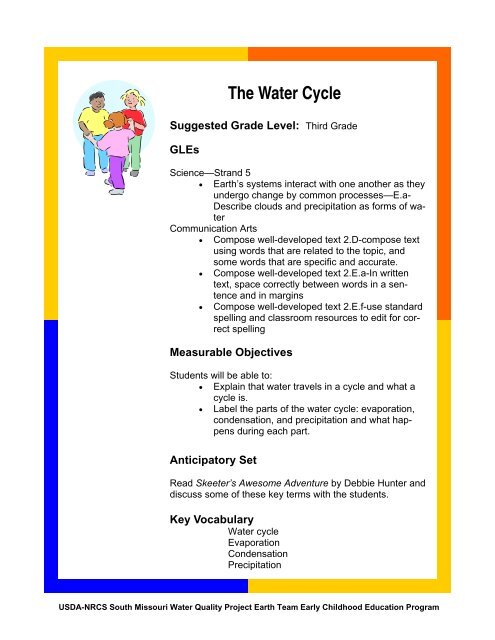The Water Cycle
The Water Cycle
The Water Cycle
You also want an ePaper? Increase the reach of your titles
YUMPU automatically turns print PDFs into web optimized ePapers that Google loves.
<strong>The</strong> <strong>Water</strong> <strong>Cycle</strong><br />
Suggested Grade Level: Third Grade<br />
GLEs<br />
Science—Strand 5<br />
Earth’s systems interact with one another as they<br />
undergo change by common processes—E.a-<br />
Describe clouds and precipitation as forms of water<br />
Communication Arts<br />
Compose well-developed text 2.D-compose text<br />
using words that are related to the topic, and<br />
some words that are specific and accurate.<br />
Compose well-developed text 2.E.a-In written<br />
text, space correctly between words in a sentence<br />
and in margins<br />
Compose well-developed text 2.E.f-use standard<br />
spelling and classroom resources to edit for correct<br />
spelling<br />
Measurable Objectives<br />
Students will be able to:<br />
Explain that water travels in a cycle and what a<br />
cycle is.<br />
Label the parts of the water cycle: evaporation,<br />
condensation, and precipitation and what happens<br />
during each part.<br />
Anticipatory Set<br />
Read Skeeter’s Awesome Adventure by Debbie Hunter and<br />
discuss some of these key terms with the students.<br />
Key Vocabulary<br />
<strong>Water</strong> cycle<br />
Evaporation<br />
Condensation<br />
Precipitation<br />
USDA-NRCS South Missouri <strong>Water</strong> Quality Project Earth Team Early Childhood Education Program
Discuss<br />
What is a cycle? Something that goes in a circle. A bicycle<br />
has two circular tires. Something that travels in a circle is a<br />
cycle.<br />
Instructional Point<br />
Students will need to have a common knowledge of water<br />
and the functions it has. <strong>The</strong>y will have to be able to sit and<br />
discuss.<br />
Procedures<br />
Define the key vocabulary terms at the board and provide<br />
examples of when students may have witnessed<br />
evaporation or condensation.<br />
Examples of evaporation include:<br />
Examples of condensation include:<br />
Demonstrate the cyclical movement of water either by<br />
drawing the water cycle at the board, or sharing a poster<br />
of the water cycle.<br />
Explain that in the experiment to follow, we will be creating<br />
a mini water cycle.<br />
Materials<br />
Steam rising from a pot of water<br />
Puddles that have dried up<br />
<strong>Water</strong> sitting in a bowl that seems to disappear<br />
after a few days<br />
<strong>Water</strong> droplets forming on the outside of your<br />
water glass<br />
A foggy mirror in the bathroom<br />
Foggy windows in a car<br />
Markers<br />
Warm <strong>Water</strong><br />
Plastic wrap<br />
Marble<br />
Plastic bowl with flat bottom<br />
Baby food jar<br />
Salt<br />
White Board (optional)<br />
USDA-NRCS South Missouri <strong>Water</strong> Quality Project Earth Team Early Childhood Education Program
Modeling<br />
<strong>The</strong> teacher will provide visual examples of the water<br />
cycle with labels.<br />
Check for Understanding<br />
Place a tablespoon of salt in the bottom of the plastic<br />
bowl. Fill with about 1 inch of warm water. Taste water<br />
with a finger to see if the salt can be tasted.<br />
Place the empty baby food jar in the center of the water.<br />
Cover plastic bowl with plastic wrap. Set the marble on<br />
the center of the plastic wrap above the baby food jar.<br />
Place in a sunny spot for a few hours, or one day.<br />
Later, check inside the baby food jar. <strong>The</strong>re will be<br />
fresh water. Taste it to see if it tastes salty. <strong>The</strong> warm<br />
water from the bowl evaporated, created condensation<br />
when it hit the cool plastic wrap, traveled down the plastic<br />
wrap to the center due to the weight of the marble,<br />
and dripped into the baby food jar as precipitation.<br />
Guided Practice<br />
Ask students to share their knowledge of the experiment by<br />
relating it to the parts of the water cycle. Tell where there<br />
was evaporation, condensation, and precipitation in the experiment.<br />
Independent Practice<br />
Ask students to draw and label the parts of the water cycle.<br />
Closure<br />
Teach the <strong>Water</strong> <strong>Cycle</strong> Song: (to the tune of She’ll Be<br />
Coming ‘Round the Mountain)<br />
“<strong>Water</strong> travels in a cycle, yet it does. <strong>Water</strong> travels in a<br />
cycle, yes it does. It goes up as evaporation, the clouds<br />
make condensation, it rains down precipitation, yet it<br />
does.”<br />
USDA-NRCS South Missouri <strong>Water</strong> Quality Project Earth Team Early Childhood Education Program
Evaluation<br />
Check the students labeled drawings of the water cycle for<br />
understanding and correctness.<br />
Lesson plan compiled by Stephanie Gibson, an Earth Team<br />
Volunteer and Early Childhood Education student at Missouri<br />
State University, Springfield, MO May 2010<br />
USDA is an equal opportunity provider and employer
















